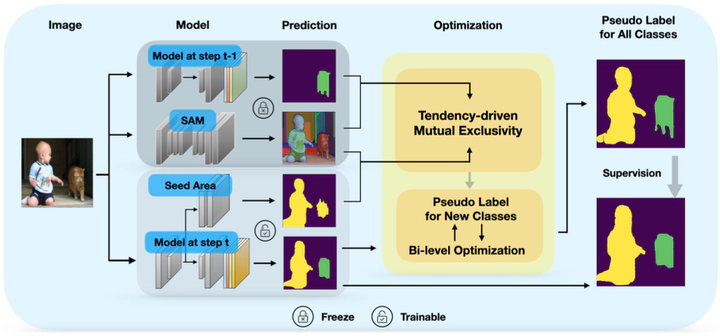Tendency-driven Mutual Exclusivity for Weakly Supervised Incremental Semantic Segmentation
 Framework
FrameworkAbstract
Weakly Incremental Learning for Semantic Segmentation (WILSS) leverages a pre-trained segmentation model to segment new classes using cost-effective and readily available image-level labels. A prevailing way to solve WILSS is the generation of seed areas for each new class, serving as a form of pixel-level supervision. However, a scenario usually arises where a pixel is concurrently predicted as an old class by the pre-trained segmentation model and a new class by the seed areas. Such a scenario becomes particularly problematic in WILSS, as the lack of pixel-level annotations on new classes makes it intractable to ascertain whether the pixel pertains to the new class or not. To surmount this issue, we propose an innovative, tendency-driven relationship of mutual exclusivity, meticulously tailored to govern the behavior of the seed areas and the predictions generated by the pre-trained segmentation model. This relationship stipulates that predictions for the new and old classes must not conflict whilst prioritizing the preservation of predictions for the old classes, which not only addresses the conflicting prediction issue but also effectively mitigates the inherent challenge of incremental learning - catastrophic forgetting. Furthermore, under the auspices of this tendency-driven mutual exclusivity relationship, we generate pseudo masks for the new classes, allowing for concurrent execution with model parameter updating via the resolution of a bi-level optimization problem. Extensive experiments substantiate the effectiveness of our framework, resulting in the establishment of new benchmarks and paving the way for further research in this field.
Publication
The 18th European Conference on Computer Vision